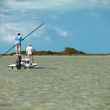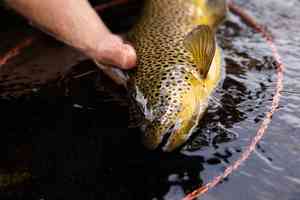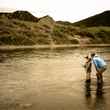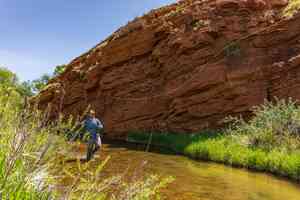Over the last two decades, the federal government has invested about $17 billion of your money into the effort to save salmon and steelhead in the Snake River basin. It might be one of the most expensive government boondoggles in our nation’s 246-year history. Yet, not a single Snake River salmon or steelhead run is even remotely better off now than it was at the turn of the century.
After more than 20 years of failed recovery policy and broken promises from politicians — from both sides of the aisle — it’s now or never for salmon and steelhead in the Snake River. The fish that give the Northwest its identity are on the verge of extinction. Avoiding that outcome is going to require action. Bold and politically difficult action. If salmon and steelhead are to have a future in the Snake River basin, the dams must come out.
But, in central and eastern Washington, home to all four lower Snake River dams, two elected U.S. Representatives are standing firmly in the way of science, common sense and salmon and steelhead recovery. U.S. Rep. Cathy McMorris Rodgers and Dan Newhouse, both of whom have spent years willfully misleading voters in their districts by insisting that the dams are just too important to remove and that salmon and steelhead can be saved without removing the dams, despite 22 years of failed policy and a complete lack of empirical evidence to back their claims.
Both Republicans are deeply indebted to the agriculture and utilities industries for their political success—they’re part of an exhaustive corporate campaign to keep the dams in place, despite the benefits a free-flowing Snake River would have for the people of the region, the recreation economy and, most importantly, the fish themselves. And both are facing re-election challenges this fall, though neither challenger — Natasha Hill for McMorris Rodgers and Doug White for Newhouse — is considered a serious threat. Since 2004, McMorris Rodgers has been elected every two years with at least 56 percent of the vote.
And the future of the West’s most iconic fish is on the line. The return of McMorris Rodgers — whose district includes the four lower Snake River dams — to Congress may very well mark the end of the return of Chinook and steelhead to the Snake. But with the Democrats mounting ineffective, feeble challenges to Republican legislators vociferously opposed to dam removal and already elected Democrats unwilling to take a meaningful stand for the imperiled fish, who will fight for Snake River salmon and steelhead?
Some forgotten history
If you were around and paying attention in the 1990s and into 2000, you know that Snake River salmon were listed as endangered under the federal Endangered Species Act in 1991 — a move that legally required the feds to begin recovery and protection action to reverse that status. Few recall a 2000 environmental impact statement from the National Oceanic and Atmospheric Administration that recommended breaching the lower four dams on the lower Snake River in order to save salmon (twenty-two years later, that same federal agency again recommended breaching the dams, this time with a nod to the storied pod of southern resident orcas that move between British Columbia and northern California and now numbers fewer than 75 animals that depend heavily on salmon from the Columbia basin). Conservation groups, fishing interests and Indigenous tribes quickly got on board, and there was real momentum for dam breaching.
That was about as close to dam removal and Columbia and Snake River salmon and steelhead recovery as we’ve ever been. I remember working in a newsroom in northern California at the time, thinking that if we could figure out a way to remove dams on the mighty Snake River, could the dams that kill salmon and steelhead on the much-more-demure Klamath River be next? As a journalist, I was attentive. As an angler, I was borderline giddy.
And then reality set in. It was July 2000, and a heated presidential election was brewing, with Vice president Al Gore facing off against Texas Gov. George W. Bush. It was the twilight of the eight-year Clinton administration. Many in the environmental community were convinced that Gore would beat Bush, and full-page ads were purchased in America’s most influential newspapers at the time, prodding Gore to go on the record as the staunch environmentalist he claimed to be and make it official — take out the dams, Al!
Gore never budged, though, even after Bush prodded him to make a decision. In typical Democratic fashion — God forbid anyone upset a single voter in blood-red Idaho or eastern Washington — Gore wobbled. Bush, on the other hand, was crystal clear.
"Al Gore should take a stand," Bush said in a campaign statement picked up by CNN. "I say we can use technology to save the salmon, without leaving the door open to destroying these dams."

But it was Clinton who dealt the dam removal effort a fatal blow. He was prepared to send George Frampton, the chairman of the White House Council on Environmental Quality, to testify before Congress in July 2000. After months of build-up and anticipation, there were many in the conservation community who believed Clinton would, at the 11th hour in his administration, do whatever he could to start the dam-removal ball rolling. Frampton’s prepared testimony was never actually entered into the record because the Senate Energy and Natural Resources Committee canceled a hearing on the matter, and, if the White House hadn’t released an advanced copy of Frampton’s testimony to the press, the world might never have known that the Clinton White House “will not recommend an immediate petition to Congress to authorize breaching of the Snake River dams.”
Later that day, after the canceled hearing, Frampton was quick to try and backtrack. He released a statement claiming press reports noting the administration's opposition to dam removal were off base. Here’s the complete statement:
Contrary to press reports this morning, the Administration is not "opposed" to the breaching of Snake River dams. We intend to develop objective performance standards to determine whether endangered salmon runs in the Columbia Basin are rebounding, and to assess the need for dam removal on those standards. Our proposal will involve aggressive steps to save salmon throughout the Basin. We cannot be sure based on the best science available today whether the dams will need to be breached in order to achieve our recovery goals. Breaching would be a last resort, but one we must be prepared to take if necessary. Extinction is not an option. It is the responsibility of the federal agencies to do everything they can to save these runs, but it must be a cooperative effort with States and Tribes, and Congress must give us the resources we need. Saving these imperiled salmon is an extraordinarily complex challenge, but I am confident that working together we can succeed.
More than two decades later, it’s clear that betting on Frampton’s confidence would have been a sucker’s play. And the most notable phrase in the hastily crafted statement? “Extinction is not an option.”
Extinction Looms
As it turns out, extinction is an option. Despite decades of science, reams of empirical data, ever-dwindling salmon and steelhead returns, and climate change that exacerbates the impacts of the dams on the Snake and Columbia rivers, nothing has been done to improve the runs from the Pacific to high-country spawning streams of the Oregon and Idaho mountains. A lot has been done — $17 billion worth of trucking salmon around dams, annually stocking tens of millions of hatchery clones into the rivers, studying water levels and water temperature and improving stream habitat where salmon have historically spawned. But, as the lone voice of reason in Congress, U.S. Rep. Mike Simpson (R-Idaho) notes, nothing has worked.
Will we spend $20 billion more in the next 30 years only to have them go extinct anyway? The worse they get, the more we will spend.
“Despite spending over $17 billion on fish recovery efforts, Idaho salmon and steelhead numbers are not improving and will continue to get worse,” a statement from Simpson’s office reads. Simpson is pushing for dam removal, and not just to save salmon and steelhead. The ongoing costs of trying to save the fish will very likely outweigh the expense involved with dam removal. “Will we spend $20 billion more in the next 30 years only to have them go extinct anyway? The worse they get, the more we will spend.”

Not that Simpson’s plan is cheap — with a $34 billion estimated cost, it’s a tough pill to swallow. Keep in mind, though, that it’s not just a dam-removal bill — Simpson’s plan includes investing in updated transportation to replace barging; investments in the communities of Lewiston, Idaho, and Clarkston, Wash., to improve riverside access and promote tourism; investments in and requirements for renewable and replacement energy projects to be functional and online before the dams come out; and creates the new Center for Advanced Energy Storage at the Pacific Northwest National Laboratory (including a tech campus in Lewiston/Clarkston). Here’s the real kicker, though. Simpson’s plan would remove the electric utilities from fish management — that responsibility would fall to the states and the Indigenous tribes in the region.
But is there time for all that? Can the fish hang on that long? Perhaps, if we started tomorrow, maybe.
According to Russ Thurow, a U.S. Forest Service fisheries research scientist in Idaho, the prospect of extinction is very real. “It’s hard to say, but now these fish have maybe four generations left before they are gone,” he told the New York Times in 2019. “Maybe 20 years.”
The Middle Fork of the Salmon River in Idaho — the fabled “River of No Return” — before the construction of the four dams on the lower Snake River, used to host a spawning run of Chinook salmon that reached into the tens of thousands. In good years, 50,000 giant fish, having migrated 800 miles upstream from the Pacific, would crowd into the Middle Fork and its tributaries to make the next generation of salmon.
These days, that number is closer to 1,000 fish. Hindsight is 20/20 and extinction isn’t just an option. It appears as though it’s the most likely option.
Those dams on the Klamath? The construction project to begin the removal of all four dams built between 1918 and 1962 starts early next year. And actual dam removal will begin in June 2024. This project may very well save Klamath and Trinity river salmon and steelhead.
What’s more, the dam removal effort on the Klamath was done via agreement among stakeholders — the utility company that owns the dams, the states of California and Oregon, the Federal Energy Regulatory Commission and the Indigenous tribes in the region. Congress refused to approve it, so the players got busy and made it happen through the sheer will to save salmon and steelhead, something that, save for a single Republican lawmaker and a host of conservation groups, is lacking on the lower Snake River.
Snake River salmon? Going by Thurow’s best guess, they have 17 years left.
Inaction continues to this day
Last month, Washington Gov. Jay Inslee and U.S. Sen. Patty Murray of Washington, both Democrats, released a flacid report that basically concluded, “Oh, sure, we’ll get behind dam removal, just as soon as we can make sure everybody is left whole once the dams come out.” This is just a year removed from both politicians publicly opposing dam removal, and about three years after Simpson released his proposal that does virtually the same thing. Honestly, what’s worse? Opposing the notion? Or throwing a wet blanket over the hopes of most people in the region who are dying for some political leadership from the state where the dams back up the Snake and choke off access to largely intact salmon and steelhead spawning habitat in Idaho?
Here’s the conclusive statement from Inslee and Murray:
“The impacts and benefits of breaching the dams are significant, but they can and must be mitigated or replaced. Until the energy and economic benefits of the dams are replaced or mitigated, breaching is not a feasible or responsible option.”

They lay the responsibility for dam removal at the feet of Congress, where exactly one lawmaker in the Northwest — Republican U.S. Rep. Mike Simpson of Idaho — stands ready to do whatever it takes to restore salmon and steelhead to his state. Simpson might be the most progressive lawmaker in the region when it comes to conservation — his work permanently protecting large landscapes of wild country in his state is generational, and it flies in the face of the generally tepid support given to conservation issues by other members of his party. But Simpson’s plan didn’t make the cut in the recent round of federal infrastructure funding, even though it would have created thousands of Northwest jobs and is the only plan on the table that gives salmon and steelhead in the Snake River a fighting chance.
Inslee and Murray, two lawmakers who brand themselves as progressives? Mitigation. Replacement. More studies. More money.
Most importantly, they want what the salmon and steelhead don’t have. More time.
The only thing less inspiring than the Inslee-Murray “hurry up and wait” scenario was the predictable response to their report from U.S. Reps.McMorris Rodgers and Newhouse, both Washington Republicans, and both staunch supporters of the salmon-killing dams on the Snake River.
“For months, [Inlsee and Murray] led a sham process paid for by Washington taxpayers and pandered to radical environmental groups who ignored the facts in pursuit of what is still their end goal — breaching the Lower Snake River dams,” McMorris Rodgers said in a statement that borrows heavily from the American political rift and panders to their far-right base.
“Gov. Inslee and Sen. Murray are trying to have their cake and eat it too with their recommendation released this afternoon calling for a plan to replace the benefits of the Lower Snake River Dams to enable breaching to move forward,” Newhouse said after the Aug. 25 Inslee-Murray report hit the streets. “This report outlines what central Washington has known all along: there is no reasonable replacement for the Lower Snake River Dams.”
Except, there is. As a 2018 study showed — that replacement is a free-flowing Snake River, with the dams’ feeble power generation contributions replaced by higher-capacity, more cost-effective, more reliable renewable energy sources. But rural voters in eastern Washington and northern Idaho continue to be misled by the likes of McMorris Rodgers and Newhouse, who portray dam removal as a sinister, left-wing conspiracy. While most of these folks would love to fish for salmon and steelhead again, they’re not about to support the removal of the dams while their elected leaders spin tales about the supposed calamities dam removal would mean for their towns and local communities.
So here we sit. The doomsday clock for Snake River salmon and steelhead is ticking. We know what it will take to save them. We know how to do it. Hell, we even have the wherewithal to replace the miniscule power the dams produce (about 4 percent of the Northwest’s power supply) with renewable energy. We also have the ability to put federal infrastructure funding to work improving rail transportation for Idaho commodities from the fake port city of Lewiston, Idaho, to the mouth of the Columbia.
But we must have the courage and the political will to stand up to the blowhards in Washington who have embraced the divisiveness and nastiness of the day and continue to traffic in fear and hatred to stall progress. And let’s be clear about one thing: there is no other option to save Snake River salmon and steelhead other than dam removal. Anybody who claims differently is lying. What’s worse? They know they’re lying.
What’s at stake?
The Columbia River used to be the most productive steelhead and salmon river in the Northwest. It wasn’t even close. Hundreds of thousands of chinook and sockeye salmon migrated up the river, and many of them traveled the better part of 1,000 miles to the top of Idaho, near the source of the Salmon River above the town to Stanely, to spawn. We slowly tamed the Columbia with four dams. The first dam, Bonneville, was completed in 1937, and the last lower Columbia Dam, the John Day, was built in 1971. With the construction of the Dalles and McNary dams (1957 and 1954 respectively) the decline of salmon and steelhead began in earnest.
But it was the four dams on the lower Snake River that really blunted the annual migration up the Snake. Today, the lower Snake below Lewiston is little more than a series of tepid reservoirs that flow into one another. And while it’s commonly understood that the dams block upstream migration, the vast majority of salmon killed by dams are lost as they migrate to the ocean, not on their way home to spawn. Salmon smolts swim the entire length of their downstream migration tail first, using the river’s natural current to deliver them to the Pacific. Since the dams essentially wipe out the current of the once-mighty Snake, many of the smolts end up lost in a slow-moving reservoir, extending their treacherous migration and making them susceptible to introduced invasive species, like smallmouth bass, carp and walleye. The few fish that do make it to the ocean are underfed, undersized and, genetically, virtually all the same thanks to the wonders of hatchery science.
We’ve lost much of the salmon and steelhead “portfolio” — the conglomeration of runs that would sometimes happen weeks or even months apart, and provided at least some certainty for the species. Should some unforeseen natural disaster take out one run of fish, another run would be on its way shortly. You’ve heard of spring chinook and summer steelhead, right? There are also winter steelhead and summer kings, although, in the Columbia and Snake systems, these alternate runs are largely gone. In other words, the portfolio is thin, and that’s why biologists like Thurow believe that salmon returning to Idaho are on the precipice of going away forever.
So, the question remains — one every interested angler, naturalist, conservationist or anyone who just wants to see salmon and steelhead return in numbers that could once again support a viable fishery (and meet all those pesky tribal treaties we signed guaranteeing there would always be salmon for Indigenous Americans) should be asking their elected officials: Why are those damned dams still there?
It’s also fair to ask lawmakers like McMorris Rodgers—who has raised more than $131,000 in the ongoing 2022 election cycle from electric utilities—who she’s really supporting? Her constituents? Or her paid sponsors? Same goes for Newhouse, who has raised $179,000 from agriculture interests and electric utilities in the 2022 cycle alone.
Unfortunately, neither candidate is facing a serious political challenge in November. Natasha Hill, a Spokane Democrat who’s running against McMorris Rodgers, has offered no public-facing position on the lower Snake River dams. Calls to her office were sent directly to voicemail, and requests for comment have gone unanswered.
Doug White, Newhouse’s Democratic challenger, was quick to challenge Newhouse and his position on the dams.
“I’m insanely frustrated by my opponent’s position on this issue,” White said. “He continually rails against dam removal but offers no concrete solutions to save salmon.”
But White also takes issue with Simpson’s plan to remove the dams.
“His (Simpon’s) plan includes a poison pill,” White said. “He knows we’ll never get $34 billion to remove the dams.”
But a plan of his own?
“It’s unlikely that the dams will come out during my tenure in Congress,” he said. “It’s unlikely they’ll come out in my lifetime. All I can do is try and prepare for the future, and that means investing in better water management, better transportation — I’m backing rail — and alternative and renewable energy.”
But the future of what? The dams? Or the fish? When reminded that Snake River salmon and steelhead are likely on the precipice of extinction, and that putting forth a plan to remove dams — even at a $34 billion price tag — is, at the very least, a plan, White sounded kind of hopeless.
“I can only answer questions about things I can do something about,” he said.
And Inslee and Murray? They’re not off the hook. They played it safe last month with their diluted proposal to ensure every interest is addressed before dams could possibly come out rather than get behind Simpson’s plan that is now several years old. They’re way too late to the party, and their interest in the issue now appears purely political.
The one interest they’re ignoring? The fish.
Meanwhile, the clock keeps on ticking, and lawmakers, save for Simpson, keep dancing the political waltz around Snake River salmon. Unfortunately, it appears the fish will be gone before the music stops playing.































Comments